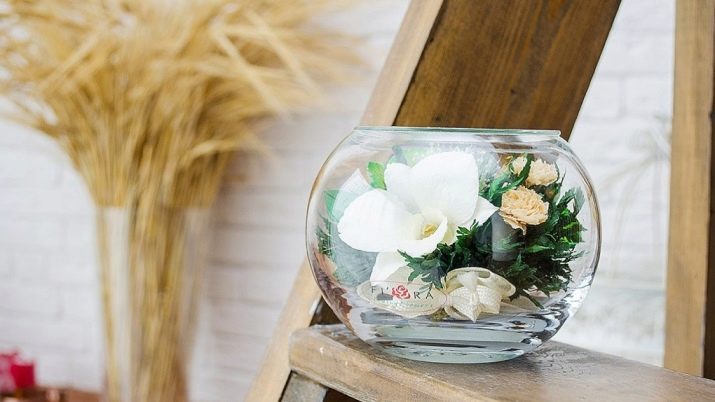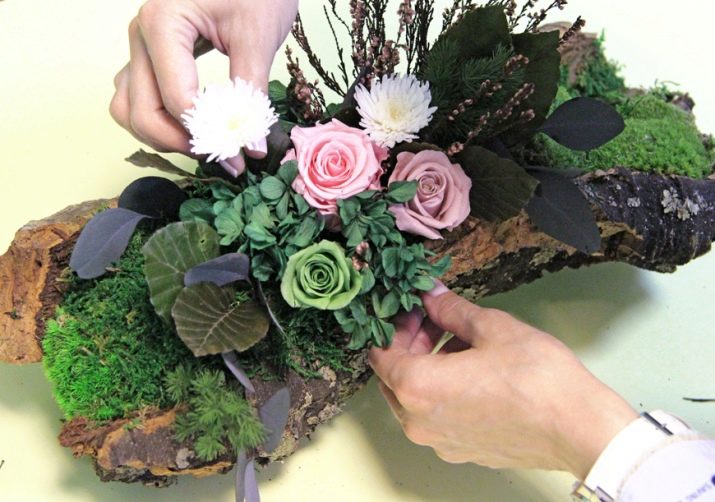Making stabilized flowers with our own hands

Graceful stabilized flowers are very often used to decorate the interior and create original crafts. They are stored for a long time and do not lose their attractiveness over time.

Stabilization features
Stabilization is the process of embalming leaves, twigs, flowers and moss. Plant processing technology is similar to that used in ancient Egypt to create mummies. During the stabilization process, the water contained in the leaves, stems and petals of plants is replaced with an embalming liquid.

Plants preserved in this way have a large number of advantages.
- Strength... Stabilized flowers, unlike dried flowers, do not crumble over time. They always look bright and beautiful.
- Environmental friendliness... Such plants are completely safe for human health. They do not emit any toxic substances. A bouquet with such flowers can be given even to allergy sufferers.
- Naturalness... Stabilized plants are almost indistinguishable from living plants in appearance and touch. This explains their popularity.
- Versatility... Bright, stabilized flowers are often used for interior decoration. In addition, beautiful postcards, paintings or wreaths are made of them. Such plants are often used to decorate wedding bouquets.
- Durability... The composition of the stabilized flowers can be stored in the house for 3-5 years.



The only disadvantage of this method of processing plants is that it is not suitable for all flowers.
Only inflorescences with dense petals can be preserved: tulips, daisies, carnations or roses... But peonies, alstroemeria and other flowers, consisting of a large number of small fragile petals, cannot be embalmed in this way.

Basic ways
Before you start creating stabilized flowers with your own hands, the plants need to be prepared. In the process, you must adhere to the following rules.
- Plants must be cut at an acute angle... The cutting line should be neat and straight. The flower stem can be either long or short.
- Before processing, the prepared plants should be left in a warm and dry place for a couple of hours. During this time, surface moisture will evaporate. Leaving the plant to dry overnight is not worth it, otherwise it will start to fade. Damaged flowers cannot be embalmed.
- From the stem of the prepared plant, you need carefully cut off dried leaves... Roses also have thorns cut. This can be done with a sharp knife.
- Capacityinto which the solution or melted wax is poured must be clean... Using dirty dishes will cause the flowers to grow moldy.

After preparing the flowers and dishes, you can start processing the plants. This can be done in two main ways.
In glycerin
This method is great for canning buds. A master class on creating such flower blanks consists of the following steps.
- To begin with, a half-open bud should be slightly dry.
- In the meantime, it is necessary mix equal proportions of glycerin and water.
- After that, the plant prepared in advance needs put into solution. The liquid should cover it completely.
- The flower must be left as it is for two weeks. During this time, glycerin will completely fill the tissues of the selected flower, displacing water from them.
- To make the solution better absorbed, the stem of the flower needs to be cut a few millimeters daily.
- After two weeks, the solution will completely replace the water in the plant tissues. This will help extend its lifespan.
In the next video, you can clearly see the process of preserving flowers in glycerin.
When choosing this method of stabilizing colors, it is worth remembering that over time they will begin to lose their brightness.
Therefore, food coloring must be added to the solution prepared according to the classic recipe. In this case, the plants will not fade. The same method is used for dyeing white flowers.
Flowers treated in glycerin solution should not be placed in water. They should be kept in an empty vase or container of sand. In addition, such flowers can be mounted on a pre-prepared frame or painting.

In paraffin
For the treatment of plants, paraffin mass is also used. The master class on creating beautiful and durable flowers consists of the following steps.
- To begin with, on a water bath you need melt paraffin... After that, it must be poured into a high container.
- The substance must be slightly cooled.... To do this, leave it for 3-5 minutes. If flowers are dipped in hot paraffin, they will deteriorate very quickly.
- After that, you can start processing the plant. The bud sinks into the paraffin mass very slowly. You need to get it out of there immediately after diving. This is done so that the petals of the flower are not deformed.
- Immediately after this, the bud must be turned over... This is necessary in order for the paraffin to penetrate into its center.
- This procedure must be repeated 3-4 times. During this time, all the petals are completely covered with paraffin.
- After that the plant must be fixed with the bud down.
After 1-2 hours, the flower can be used to create a beautiful composition. The paraffin layer on such a flower should not be too thick.



Some needlewomen prefer wax injections to paraffin baths.
The melted wax is drawn into an ordinary medical syringe. They gently pierce the petals of the bud. This injection allows you to keep the flower for 4-5 months. It looks no worse than a plant soaked in a solution with glycerin and water.
Leftover flowers can be used to create large candles or wax figures. All that is needed for this is to "drown" the small buds in paraffin / wax.The disadvantage of this method of processing plants is that after cooling, the substance will become cloudy. Because of this, the flower will be difficult to see.

Follow-up care
In order for plants, "canned" at home, to always look like living, they need to be properly cared for. To do this, you will need to adhere to a number of simple rules.
- Store such flowers away from direct sunlight. If the plants stand on the windowsill, they will fade very quickly.
- Do not allow moisture to enter the surface of the petals... For this reason, it is not recommended to store stabilized plants in the bathroom or kitchen.
- You need to clean the flower arrangement from dust, using a soft sponge or brush.
- If water gets on them during cleaning, the plants should be immediately wiped with a dry cloth.... If this is not done, ugly spots may appear on the flower petals.
- Can't be allowed and mechanical damage to plants.
- In watering, transplanting and feeding such plants dont need.

The scheme for preserving flowers in glycerin has been known to people since the middle of the last century. But she gained popularity among needlewomen only now. Modern compositions with such plants are used both in ordinary apartments and in offices. Lovely bouquets or paintings with stabilized flowers fit perfectly into the interior of almost any room.






You can visually familiarize yourself with the process of preserving flowers using paraffin in the following video.








